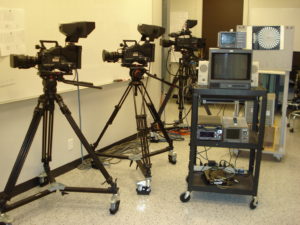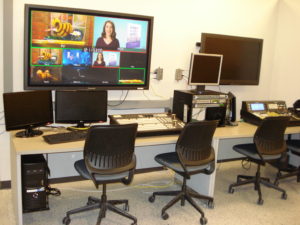By Eugene Blanchard
ICT Instructor
Information Technology Network Systems
Broadcast Systems Technology
SAIT Polytechnic
The Southern Alberta Institute of Technology’s Broadcast System Technology (BXST) program has completed the move into new lab facilities.
The BXST program, located in Calgary, Alberta, graduated its first class of Broadcast Technologists in 1969 and continues to supply the Broadcast industry with qualified graduates. The two-year BXST technology program has over the years progressed from the analog age and into the digital and IT age of radio and television broadcasting as showcased with its new facilities.
The BXST program is one of the few schools certified by the Society of Broadcast Engineers (SBE) and it’s unique as it focuses specifically on the technical engineering side.
Broadcast technologists are the support personnel for radio and video production and can be thought of as the paramedics of the broadcast industry. Broadcast technologists are responsible for the design, installation, configuration, maintenance and repair of the broadcast facility under supervision of the Chief Engineer.
Garry Shepherd, BXST Program Specialist, utilizing his past experience as Chief Engineer for CJFB-TV in Swift Current, SK, led a team of seven instructors and support staff, in coordinating the design and move to the new facilities. Interesting to note that five of the seven team members are proud past graduates of the BXST program. The design timeline was extremely short and only 3 months were allocated to complete the planning and design before construction started. To add to the fun, construction and planning occurred while regular student classes were being conducted and taught during the semester.
The original facility was built in 1969 and was housed in the John Ware building at SAIT’s main campus. Over the past 50 years as the Broadcast industry migrated from analog to digital, the equipment and facilities in the John Ware building also changed. 50 years of upgrades and modification on an older facility took its toll and money was allocated to move to a new facility as part of a larger investment and upgrade to SAIT’s 20-acre main campus.
The new facility is located on the fourth floor of the NJ wing of the Senator Burns complex. The tiered classroom is acoustically treated for sound isolation, to minimize reflections and provide a space where the students can listen and hear the differences in the many audio formats and codecs used in radio and television. An equipment rack holds the 5.1 surround sound system and equipment to interface with the radio and television equipment located in the lab. Demo antennas, cabling, beacons and more decorate the walls.
The lab facility is divided into three major areas, the first is the RF area which houses a Nautel NX3 AM transmitter, a Harris Platinum Z FM transmitter and associated equipment. Both working transmitters dump into dummy loads. A working STL link transmits from the RF area to the other end of the lab to the radio area.
 The second area is the radio area which has an acoustically isolated and treated audio room housing an analog on-air radio console and Axia core digital control console with associated equipment. Outside of the audio room is the racks housing the Axia core and a Wide Orbit network aptly called the “RadioActive” network. The Wide Orbit systems consists of the main server and two local affiliate stations. There is also an acoustic isolation booth for testing of microphones and speakers.
The second area is the radio area which has an acoustically isolated and treated audio room housing an analog on-air radio console and Axia core digital control console with associated equipment. Outside of the audio room is the racks housing the Axia core and a Wide Orbit network aptly called the “RadioActive” network. The Wide Orbit systems consists of the main server and two local affiliate stations. There is also an acoustic isolation booth for testing of microphones and speakers.
The video area is the largest and within the HD camera section is home to three Sony CA327 HD cameras on pedestals. A DMX lighting system consists of PAR fixtures, robo fixtures and an IKAM RB5 color correction fixture – all controlled by a Behringer LC2412 lighting console.
Next to the camera area, is the video switcher area which has a Ross Carbonite switcher and a Ross Synergy 1 switcher. Tek rasterizers are used throughout to monitor and measure the digital video signals. The video racks hold the two Italia SD and HD audio and video routing matrices and the RTS intercom system. House sync is provided by a Tek TG700 and a Tek SPG8000A signal generators plus associated audio and video distribution amplifiers.
 A Rhodes and Schwarz SLx8000 digital TV transmitter is attenuated so that reception is available just within the lab which meets our licensing requirements. The ASI feed is generated by Tandberg, Adtec and Memphis digital encoders that are multiplexed by a Logic Innovations TSM-8000 ASI multiplexer. Ingest feeds are available from our roof-top 3m satellite dish through satellite receivers and the remote control positioning system.
A Rhodes and Schwarz SLx8000 digital TV transmitter is attenuated so that reception is available just within the lab which meets our licensing requirements. The ASI feed is generated by Tandberg, Adtec and Memphis digital encoders that are multiplexed by a Logic Innovations TSM-8000 ASI multiplexer. Ingest feeds are available from our roof-top 3m satellite dish through satellite receivers and the remote control positioning system.
Next to the digital TV transmitter equipment, is the Miranda ITX system, Ross Overdrive system, Teradek and the Ross Expression. DVCPro digital video tape players, Ross digital servers, Black Magic Design HyperDeck video server and a 4k camera provide video sources.
The goal was to have at least one example of every piece of equipment that would be found in a radio, television or production facility. Students work individually or in small groups of 2 or 3 and there are usually multiple lab assignments being performed during any one lab due to equipment quantities.
The lab is well laid out with adequate room for the small lab sizes of 16 students. Theory classes consist of a maximum of 32 students divided into two lab cohorts with the school year start in the Fall. BXST graduates find work throughout Canada and the U.S. working in radio, television, production and for manufacturers.
Subscribe Now – Free!
Broadcast Dialogue has been required reading in the Canadian broadcast media for 25 years. When you subscribe, you join a community of connected professionals from media and broadcast related sectors from across the country.
The Weekly Briefing from Broadcast Dialogue is delivered exclusively to subscribers by email every Thursday. It’s your link to critical industry news, timely people moves, and excellent career advancement opportunities.
Let’s get started right now.




